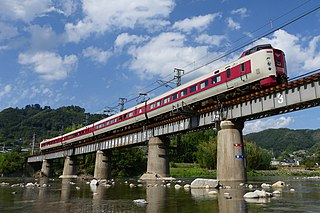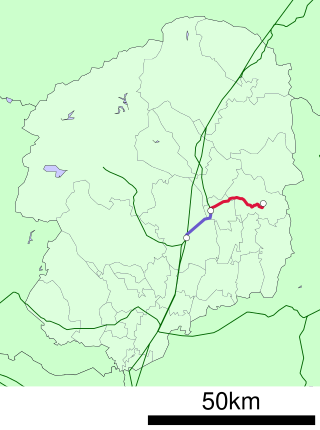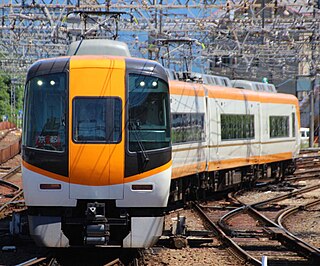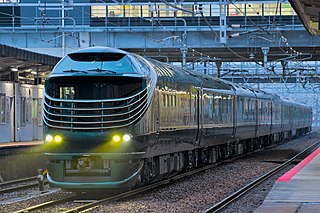
The Hakubi Line is a railway line operated by West Japan Railway Company in the mountainous area of the Chūgoku region of Japan. It begins at the south end of Okayama Prefecture at Kurashiki Station in Kurashiki, passing through Niimi Station on the west side of Niimi, and terminating at Hōki-Daisen Station in Yonago, Tottori Prefecture, linking Okayama Prefecture and Yonago across the Chūgoku Mountains. The Hakubi Line follows the Takahashi River between Kurashiki and Niimi, and the Hino River between Shōyama and Hōki-Daisen.

The 313 series is a DC suburban electric multiple unit (EMU) train type operated by Central Japan Railway Company in Japan since 1999.
The Gauge Change Train(GCT) or Free Gauge Train is the name given to a Japanese project started in 1994 to develop a high-speed train with variable gauge axles to allow inter-running between the 1,435 mmstandard gauge Shinkansen network, and the 1,067 mm narrow gauge regional rail network.

The Kintetsu 22600 series "Ace" (近鉄22600系「Ace」) is a limited express electric multiple unit (EMU) train type operated by Kintetsu Railway since 1 April 2009.

The 683 series is a dual-voltage electric multiple unit (EMU) train type operated by West Japan Railway Company (JR-West) and Hokuetsu Express on limited express services in Japan since 2001.

The Karasuyama Line is a railway line in Tochigi Prefecture, Japan, owned and operated by East Japan Railway Company. It connects Hōshakuji in the town of Takanezawa with Karasuyama in Nasukarasuyama.

The 225 series is a DC electric multiple unit (EMU) train type operated by West Japan Railway Company (JR-West) on suburban services in the "Keihanshin" Kyoto-Osaka-Kobe area since December 2010.

The 287 series is a DC electric multiple unit (EMU) train type operated by West Japan Railway Company (JR-West) in Japan on limited express services such as the Kinosaki and Kounotori from Kyoto and Osaka since 12 March 2011. 287 series EMUs were introduced on Kuroshio services from the start of the revised timetable on 17 March 2012.

The "NE Train" (NEトレイン) was an experimental railcar which has been used to test a number of alternative power sources by the Railway Technical Research Institute (RTRI) and East Japan Railway Company in Japan since 2003.

The E7 series and W7 series Shinkansen are Japanese high-speed train types operated by East Japan Railway Company and West Japan Railway Company, respectively. They were jointly developed.

The Kintetsu 50000 series (近鉄50000系) is an electric multiple unit (EMU) train type operated by Japanese private railway operator Kintetsu Railway for use on luxury Shimakaze limited express services since March 2013.

The EV-E301 series (EV-E301系) is a two-car battery electric multiple unit (BEMU) train type operated by East Japan Railway Company on the Karasuyama Line and Tohoku Main Line since 15 March 2014. The train goes by the nickname "Accum".

The Kintetsu 22000 series "ACE" (近鉄22000系「ACE」) is a limited express electric multiple unit (EMU) train type operated by the private railway operator Kintetsu Railway since 1992.

The 227 series is a DC electric multiple unit (EMU) train operated by West Japan Railway Company (JR-West) for use on suburban services in the Hiroshima area of Japan since 14 March 2015, with plans for additional sets in the Kinki Region beginning in 2019.

The 323 series is a DC electric multiple unit (EMU) train type operated by West Japan Railway Company on the Osaka Loop Line in Osaka, Japan, since December 2016. The trains replaced the ageing 103 series and 201 series trains.

The 87 series (87系), branded Twilight Express Mizukaze, is a luxury hybrid diesel multiple unit (DMU) sleeping-car excursion train operated by West Japan Railway Company in Japan since 17 June 2017. With a capacity of 34 passengers, the train is used on excursions in the Keihanshin, Sanin, and Sanyo regions of western Japan.

The EV-E801 series is a two-car battery electric multiple unit (BEMU) train type operated by East Japan Railway Company on the Oga Line in Akita Prefecture in northern Japan since 4 March 2017.

The BEC819 series (BEC819系), branded "DENCHA", is a two-car battery electric multiple unit (BEMU) train operated by Kyushu Railway Company on inter-running services over the Fukuhoku Yutaka Line and Chikuhō Main Line in Fukuoka Prefecture in northern Kyushu, Japan, since October 2016, and also on the Kashii Line.

The Meitetsu 9500 series (名鉄9500系) is an electric multiple unit (EMU) train type operated by the private railway operator Meitetsu in Japan since 2019.

The HC85 series is a diesel-electric multiple unit (DEMU) train type built Nippon Sharyo for use on limited express services operated by Central Japan Railway Company. Intended to replace the KiHa 85 series, a prototype trainset was completed in late 2019, with a full-production fleet first materializing in 2022. The fleet was first introduced into service on 1 July 2022 on the Takayama Main Line.




















